|
|
|
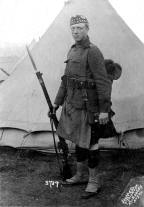 |
|
 |
 |
Fraser and Other Family Members in World War I
I am a child of the Second World War, born at Bovington Military Hospital in Dorset, where my father Harold Fraser (1907-76) was an instructor in the Royal Armoured Corps at the Tank Training School, in September 1945. My mother, Marjorie Mabel Hughes (1906-91), came from Nayland in Suffolk, and met my father when she was working in a munitions factory in Chelmsford Essex. This short article collects all the photos I’ve inherited from both families relating to World War I. Many other family members on both sides served (and died) in World War I, but unfortunately I have no photos of them. For my complete family tree, see here.
Revised: 19 September, 2024
The Fraser Family
My father Harold Fraser was born in Liverpool in 1907, youngest of twelve children, with four brothers (one of whom died in infancy) and seven sisters. Two brothers served in World War I, Francis Alexander Fraser (1888-1972) and Reynold Fraser (1892-1971). Like my Dad, the third surviving brother William Edward Fraser (1903-75) was too young to serve.

Francis Alexander Fraser
(1888-1972)
I don’t have any photos of Frank Fraser from World War I, but I do have some documents from his service record and his 1938 photo album, which has some interesting pictures from that period. Frank returned to Liverpool from the USA aboard the “RMS Pannonia” in 1916, and served in the Royal Field Artillery (now part of the Royal Artillery) from 1916-19, ending the war as a sight gunner. He returned to the USA in Sep 1919, this time on the “SS Scotian”.
From Frank Fraser’s photo album, my uncle Reynold Fraser (1892-1971) in the uniform of the 10th Battalion, King's Liverpool Regiment (Liverpool Scottish), which he joined on 29 Sep 1914.
The professional photos left and centre were identified by Dennis Reeves of Liverpool Scottish Regiment Museum Trust as having been taken at King's Park, Edinburgh, October 1914. Reynold Fraser is on left in the first photo.
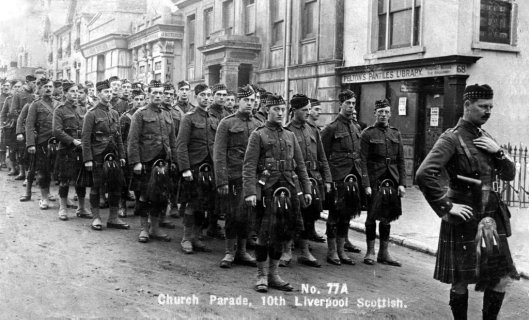

Postcard of 10th Battalion, King's Liverpool Regiment
(Liverpool Scottish),
Tunbridge Wells, Kent, 1914
Reynold Fraser is on the right in the front row above the word "Scottish"
The reverse of this postcard is franked 1 Nov 1914.
Ironically the added note at top left says "The war will soon be over now that
we are going out."
Several years ago I sent in the postcard above to “Family Tree Magazine” and Ian Swinnerton corrected the postcard caption of “10th Liverpool Scottish” to “10th Battalion, King's Liverpool Regiment (Liverpool Scottish)”. My uncle Reynold Fraser (“Ren”) born 25 Oct 1892 is on the right below the word “Pantiles”. The reverse of the postcard is addressed to his fiancée Mary Wareham in Litherland and franked 1 Nov 1914. Ian told me that the battalion left Tunbridge Wells for France on 1 Nov 1914 (the Sunday and the day the postcard was franke, sailing on the “SS, sailing on the “SS Maidan” from Southampton. Reynold served in France and Flanders until 3 June 1915, when he was wounded at Sanctuary Wood, east of Ypres, in Belgium.
From the Liverpool Scottish Adjutant’s personal note book, 3 June 1915: “Warm sunny day, our men on the right did a great deal of sniping, Lance Corporal Leach of X Company accounting for a German officer and one man. Unfortunately the Lance Corporal was shot through the head and died almost immediately. Private Campbell of Z Company was also wounded in the head. The back of the dug outs proved to be an “unhealthy” spot in both ways – it was very unsanitary and an enemy machine gun was able to enfilade it from away on the right. Private Theakstone (SB - stretcher bearer) and Private Fraser, V (Victor) Company, were hit, the former through the head (he died in hospital), and the latter through the elbow. Improvement of the traverses was started at once (Private Donnelly, Y Company 3729 was wounded in the hand in the 3rd instant). The GOC Brigade and the Brigade Major visited the trenches in the afternoon and the day passed without incident. Captain Wood and Lt Thessler 5th DLI (Durham Light Infantry) stayed 24 hours.”
Reynold was evacuated to England and after a spell in hospital was classed as "medically downgraded" and transferred to the 49th Provisional Battalion, which was a unit of "medically downgraded men (in the main) from Lancashire regiments" that was used on home defence in Eastern England. He was posted to Hemsby in Norfolk in September 1915, where he worked on coastal defence. He qualified as an armourer and was promoted to acting Lance Corporal in June 1916 then to Armoury Sergeant in September 1916.
 |
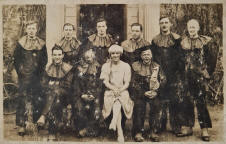 |
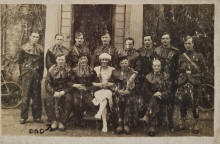 |
|
Reynold Fraser in a play at Great Yarmouth, Norfolk, 1916 |
||
Reynold transferred to the 14th Battalion South Lancashire Regiment in January 1917 as a Sergeant and was sent to Bailleul, France, in December 1917, where he served with 50th Searchlight Company. He was transferred to the Royal Engineers in January 1918 and was posted to 52nd Anti Aircraft Searchlight Company in May 1918. He was finally demobbed on 19 Jan 1919, having been awarded the 1914 Star. Reynold also served in the Army in World War 2 and was commissioned as a Lieutenant.
(Information from Dennis Reeves and Ian Riley, Liverpool Scottish Regiment Museum Trust.)
Postcard of South Road, Waterloo, Liverpool, 1914, with
probably another battalion of the King's Liverpool Regiment. My grandmother’s
sweetshop and tobacconist is marked with “X”.
Ian Riley of the Liverpool Scottish Regiment Museum Trust says of the photo taken in South Road, Waterloo: "This battalion is likely to be perhaps the 9th or 7th Battalion of the KLR or perhaps a battalion of a different regiment based at Litherland or Seaforth Barracks. The South Road picture is a very nice image; I come from Blundellsands and Crosby; I think they are marching from the sea end towards the station. That side of the road has changed almost beyond recognition, particularly since Sefton Council has put in an extremely ugly office building there."
|
Ada and Winifred Fraser in World War 1 |
Sgt. George Grimshaw, RAMC - George married Winifred Fraser in 1922 |
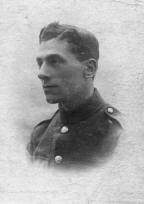 Ernest Kendrick, father of Ernest Kenrick Fraser, son of Margaret Isobel Fraser |
My aunt Ada Jarrett née Fraser (1889-1973), who served as a nurse in World War I, together with her younger sister Winifred Fraser (1897-1970). George Grimshaw (born 1896), who married Winifred in 1922, served in the Royal Army Medical Corps in World War I, ending up as a Sergeant. My aunt Margaret Isobel Fraser (“Bella”) had a son she named Ernest Kenrick Fraser in Salford in 1919. This World War I soldier was his father Ernest Kenrick. This photo was given to Ernest by his mother Bella in the early 1990s.
The Sargeant/Halewood Families
Alice Halewood (1839-1900), a younger sister of my great-grandmother Jane Halewood who married James Sargeant, married Aaron Hough (1836-91). Their son William Aaron Hough (1862-1946) married his first cousin Ellen Halewood (1863-1922), daughter of Jane Halewood's brother William and Martha Sherlock. William, Ellen, their son Frederick Hough (1890-1945) and his son Ernest Frederick (born 1913) are shown at a Royal Engineers Army Camp in Cheshire in 1915.
Also shown is a newspaper article about the death in 1915 of Sergeant John Thomas Halewood, born in Liverpool in 1881, son of Samuel Halewood and Mary Edwards. John married Bridget Dunne in 1906, but she died in 1914, leaving him with three daughters, Eileen, Josephine and Edna. Unfortunately the girls ended up in council care at Christ Church Girl's Home after John died. Eileen became a very successful nursing matron, but sadly died in Addis Ababa, Ethiopia, in 1961, see The Sargeant Family Album.
|
William Robert Paine (1888-1977) was the son-in-law of Martha Sargeant, my grandmother's elder sister, who moved to the USA in 1888. He served in the US Army Artillery in World War 1, reaching the rank of 1st Sergeant. He is shown on horseback on the right of the right-hand picture. |
The Hughes Family
Jane Campbell King (1870-1954), daughter of Clara Anna Hughes (1852-1918), front right, with her sister Mabel Maude King (born 1883) in New Zealand in 1915. At rear are her children James Stuart Paton (1891-1954) in New Zealand Army uniform and Clara Winifred Paton (born 1894). Jane married James Baxter Paton on 11 Jan 1890 in Stratford, Taranaki (North Island) New Zealand, but James died on 9 May 1900 and she married Richard William Hemingway on 16 May 1901.
Clara Anna Hughes, daughter of Thomas Hughes and the second cousin of my great grandfather Philip Hughes, emigrated to Australia with her mother Anne Last and stepfather Thomas Hall in 1856, and subsequently moved to New Zealand. Clara married Scotsman William Campbell King in Hokitika (South Island) in 1869. Jane was their first child. Their youngest son George Alexander Last King (1892-1969) was a printer and newspaper editor who became mayor of Greymouth (the largest town on the West coast of the South Island).

Mount Scopus British War Cemetery, Jerusalem, Israel, picture from Wikipedia by
Hagai Agmon-Snir
William James Hughes (known as James) born Marylebone, London, 1878, married Florence Maud Garwood in Paddington on 1902.They had four children between 1903 and 1912 but James was sadly killed in Jerusalem, then Palestine, on 8 Dec 1917, serving with the 12th Battalion Norfolk Yeomanry. He is buried in Mount Scopus British War Cemetery, Jerusalem.
Both my uncles Cyril Hughes and Charlie Hughes served in World War II. Charlie survived Dunkirk, but died in Feb 1945 of pneumonia.
The Hatten Family
My grandmother who married William Hughes was Mabel Elizabeth Hatten (1880-1950) and these photos show her cousin Frederick Stanley Hatten (1888-1971) in 1915 and in the 1920s in the uniform of the 7th Seaforth Highlanders of Canada (72nd Infantry Battalion, Canadian Overseas Expeditionary Forces), the celebrated Canadian kilted regiment. Private F S Hatten fought at Vimy Ridge in France in 1917 and is listed in an Appendix to the book “History of the 72nd Canadian Infantry Battalion, Seaforth Highlanders of Canada”, Bernard McEvoy (1920) - the front book title "72nd Seaforth Highlanders of Canada" is incorrect, although the longer title inside is correct. Frederick Stanley Hatten (known as "Stan") born in Ipswich in 1888, emigrated to Canada in 1910 and married Florence Alice Wilton, daughter of John Wilton and Mary Emeline Stewart, in Seattle, USA, in 1913. They had two daughters, Thora (1914) and Fredericka (1916), and were the grandparents of celebrated “prima ballerina assoluta” Eva Evdokimova, Thora's daughter and the highest paid female ballet dancer of the 1980s.
Stan moved to Calgary in Alberta and worked as an advertising copywriter for the "Calgary Herald" for 30 years. He moved back to British Columbia after his retirement and died in Vancouver in 1971, so he saw his granddaughter become a famous dancer. See my article in “Family Tree Magazine”, January 2011.
|
|
|
Stan married widow Lily Maud Richards née Drury around 1928. She was born in Greenwich in 1896 and married John Griffith Herbert Gordon Richards ("Griffith", born in Sheffield in 1898 of Welsh parents), in Greenwich in Jun 1918. Griffith had emigrated to Canada before WW1 and came back to Europe in the Canadian Army. They subsequently moved to Alberta, Canada, where Griffith Richards became a colliery manager and was killed in the Midland Mine Disaster, Drumheller, Alberta, Canada, 2 Aug 1924, at the age of only 26.
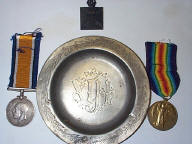
Field Communion Set and WW1 medals of Rev.
John Charles le Pelley Hatten
(1875-1943), photo by Tom Burnell (British
War Medal on the left, Victory Medal on the right)
Another Hatten family member, the Rev. John Charles Le Pelley Hatten (1875-1943), was vicar of Dallington in East Sussex from 1911-34, but served in WW1 as an Army Chaplain in France from 1914-19. In 2004 I was amazed to receive an email from Tom Burnell of the Thurles War and Famine Museum, Ireland, who had bought John’s service record, medals and communion plate on eBay! John died at St. Leonard’s on Sea in East Sussex on 30 Jan 1943 and there was speculation on the Internet that he was killed in a German air raid, but he actually died of natural causes. John’s younger brother Arthur William Hatten (1880-1916), died at his father’s home in Bexhill-on-Sea, East Sussex, this may have been from war wounds, but as he died in England he’s not listed as a casualty on www.cwgc.org.
Lt. Cdr. Harold Blomfield Hatten, MBE (1880-1973) is the longest serving commissioned officer in the Royal Navy (54 years) and his record cannot now be beaten. He joined the HMS Ganges training school in Suffolk in 1896 at the age of 16, and served in the Royal Navy and the Royal Australian Navy continuously until 1950, through both the First and Second World Wars. He served initially on HMS Lion, then transferred from the RN to the RAN on 5 Aug 1913, serving during World War 1 on HMAS Melbourne in the North Atlantic. In the Second World War he was a staff officer at the Australian Admiralty in Sydney, and he ended his career as Commander of the Western Australian training establishment HMAS Leeuwin. The picture on left was taken in Subiaco, Western Australia, 1972, and is of him with a model artillery gun before taking the salute at the passing out ceremony at HMAS Leeuwin, 21 Mar 1972.
Stanley Alexander Gibbons born 1890, son of Alfred Alexander Gibbons and Laura Elizabeth Hatten (my grandmother's first cousin) joined the Royal Sussex Regiment [8th Battalion] in 1914, and was gazetted as temporary 2nd Lt., Royal Fusiliers (City of London Regiment) on 22 Sep 1915, but was wounded on 24 Sep 1915. His commission was cancelled and a question was asked in the House of Commons by Sir Daniel Ford Goddard (MP for Ipswich from 1895-1918) on 22 Jun 1916, the reply from the Minister of War being that the commission was cancelled because Stanley had been unable to take it up.
The Cooper Family
My grandmother Mabel Elizabeth Hatten was the daughter of farmer William Hatten of Great Finborough, Suffolk and Esther Cooper of Ringshall, Suffolk. Esther Cooper’s younger sister Priscilla married solicitor’s clerk Isaac Carr and moved to Walthamstow in London. Their son Reginald Hugh Carr (1885-1968) was an early aviation enthusiast, and worked as an aero engineer and pilot at Hendon, Middlesex, from 1908. He was Awarded Aviation Certificate by Royal Aeronautical Society in June 1913, won the Michelin Cup in 1913, won the British Empire Michelin Cup for a flight of 600 miles from Hendon, and came second in the Aero Derby, also in 1913. Reg joined the Royal Flying Corps in World War I and became a noted air ace, winning the AFC (Air Force Cross), the DSM (Distinguished Service Medal) and ending the war as a Major. After World War I Reg stayed in the newly formed RAF until 1924, and then worked as a test pilot for the Grahame White Aviation Company at Hendon Aerodrome.
Royal Flying Corps officers including Major Reginald Hugh Carr, Martlesham Airfield, Suffolk, 1917 (all seven photos from Brian Gudgeon)
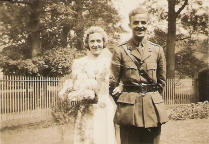
Unidentified couple in a photo that belonged to Helen
Catchpole's grandmother. Helen is the great-granddaughter of Joseph Rouse
Durrant (son of Thomas Cooper Durrant), whose sister Edith Durrant was the first
wife of Harry William Thorpe, and mother of Stanley Walter Thorpe, see the
Hatten page. The groom was a Major in the Royal Marines.
In Memoriam (World Wars 1 & 2 Casualties)
Henry Halewood Elliott, born 1894, died Gallipoli, Turkey, 11 May 1915 (RNVR)
William Harry Symonds, born 1894, died Ypres, Belgium, 16 Jun 1915 (Army)
John Jack Minshull, born 1891, died Gallipoli, Turkey, 13 Jul 1915 (Army)
Harold Crofts, born 1888, died Somme, France, 15 Jul 1915 (Army)
Henry Halewood, born 1889, died Gallipoli, Turkey (Army)
Spencer Leslie Hatten Symonds, born 1897, died Ypres, Belgium, 12 Nov 1915 (Army - brother of William Harry above)
Samuel Halewood, born 1895, died Somme, France, 11 Mar 1916 (Army)
Harry Rhodes, born 1885, probably died Somme, France, 20 Aug 1916 (Army)
John Fraser, born 1887, died at sea, 1916 (Merchant Navy)
Harry Pike, born 1891, died France, 1916 (Army)
George Frederick Davies, born 1895, died Lagnicourt, France, 5 Apr 1917 (Army)
William Laflin, born 1896, died France, 7 May 1917 (Army)
Stanley Walter Thorpe, born 1891, died France, May 1917 (Army)
Arthur Ethelstone Vince, born 1890, died Mazingrabe, France, 24 Mar 1917 (Army)
Seth Henry Halewood, born 1878, died France, 13 Jul 1917 (Army)
Edgar Vince, born 1882, died Ypres, Belgium, 26 Sep 1917 (Army)
James William Hughes, born 1878, died Jerusalem, Palestine, 8 Dec 1917 (Army)
Charles William Grimsey, born 1883, died Jerusalem, Palestine, 3 May 1918 (Army)
John Halewood, born 1884, died France, 18 Jul 1918 (Army - brother of Samuel above)
George William Bailey, born 1879, died France, 1918 (Army)
Several others came home from the war, but died afterwards from their injuries, especially after being gassed.
Thomas Meredith Dinwoodie, born 1896, died Ostend, Belgium, 29 May 1940 (Army)
Ronald Murphy, born 1915, died El Alamein, Egypt, 16 Nov 1941 (Army)
John Edward Northend, born 1920, died Mettmann, Düsseldorf, Germany, 13 Jan 1943 (RAFVR)
Desmond Norman Murphy, born 1924, died Burgundy, France, 10 Mar 1944 (RAFVR - brother of Ronald above)
Arthur Robert Oakes, born 1890, died Delhi, India, 31 May 1944 (2nd Lt., Indian Army Corps of Clerks)
John McGeachie, born 1919, died Villers-Saint-Paul, Oise, France, 2 Jun 1944 (USAAF)
Robert Elliott Matthews, born 1924, died Normandy, France, 29 Jul 1944 (Army)
William Charles Hughes, born 1912, died 6 Feb 1945 (Army) - my Uncle Charlie
Also Major Sydney Dennis Dingley, 45th Heavy Artillery, RA, born 1912, served with Major General Orde Wingate's Chindits in Burma, died in 1946 of his wartime injuries and Wilfrid Hayley Spark Hatten, born 1886, teacher at the Cathedral School, Shanghai, China, imprisoned by the Japanese during World War II, died 1952.
Thanks to Joan Coulson, Gary DeBeaubien, Linda Doyle, Brian Gudgeon, Sheila Waterfield and Helen Catchpole for the photos.
Click on the photos or the underlined links to see the picture pages. If you have any more pictures to share please contact me: alanfraser87@gmail.com
You will be credited for every picture included.
For my complete family tree, see here.